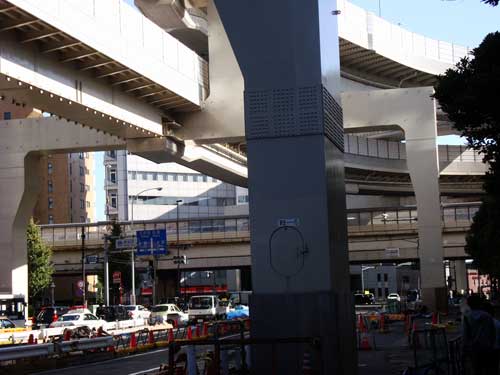
In front of Shinjuku’s Opera City, a high rise office tower with cultural facilities including theaters and a museum, four levels of stacked freeways cast shadows, pollute the air, and block pedestrian space with giant concrete support columns. The presence of even one elevated freeway undermines pedestrian life and divides neighborhoods. Are all the elevated freeways necessary for Tokyo?
Here in SF Bay Area, after the Loma Prieta earthquake was that we got rid of 3 elevated freeways and were able to reclaim the space for humans. Here in Oakland it has seemed to make a big difference. Where the elevated Nimitz structure used to be, right through the middle of West Oakland, is now a ground level parkway, which I gather has improved the area a lot. The freeway has been re-routed out through the industrial area near there and no longer messes up a residential/retail area.
Thank you Janet for the comparison. Freeway removal is a global trend that improves the livability of cities. I also noticed that your husband is a Tokyo University of Agriculture graduate, the school where I am currently affiliated. I am curious about your ideas on the relationship between miniature landscapes (specifically suiseki, or stone landscapes) and urban design. These topics of design, beauty, and the balance between nature and people also interest me.
Yes, I noticed that you were connected to Nodai 🙂 Mas studied sake brewing there (being #2 son in a sake family).
Suiseki of course are for indoors and are a way of bringing nature into the house and into human life. They aren’t exact replicas of natural scenes, but are somewhat abstracted or even idealized, representations.
Bonsai can serve a similar function – though they spend a lot less time indoors than suiseki do! They also bring the idea and imagination of the natural world into our everyday life. Of course bonsai require a lot of difficult maintenance, so most people prefer simpler container plant cultivation I think. .
Stone though speaks to so many people in such deep ways. I can’t tell you how many times people will see suiseki for the first time – perhaps at our club’s summer exhibit over at the Japan Center – and say words such as “I had no idea it had a name. Why, I’ve been collecting stones wherever I go since I was a little child”. There is something in stone that most people feel deeply.
In outdoor public spaces, what I really hate are the “plazas”. Large expanses of concrete or stone with the occasional planter. They always have benches that no one would ever wnat to sit on because there’s no reason to be there. And the result is invariably that nobody IS there. It’s empty waste space. But it seems that city planning boards and/or architects love them.
An alternative that I’ve seen is over at Yerba Buena Center in SF. Their “plaza” (or whatever they call it) is up a flight of stairs from street level, and is quite a large area with buildings around on 4 sides. It’s mainly grass, somewhat hillocky, with trees and other plantings around the edges and here and there. Around it are shops, and restaurants, etc. And lots of people – hanging out on the grass enjoying themselves. It’s right downtown, and is a lovely spot to take a break from the office, or the museum, or shopping, or whatever you’ve been doing.
There’s a nice tea house, and other places to take the weight off the legs or you can get a sandwich or something and eat on the grass, or do whatever you want!
Your post about the barely used community gardens that you can’t photograph and can hardly get to had made me think of it. I think people love big, busy, exciting cities with lots of tall buildings and cool architecture. And in the middle of it they need a bit of grass where they can take their shoes off and do whatever they want, and they need something that helps them imagine their last trip to the mountains or the forest and lose themselves a little bit.
Even if you can only have a few really big parks in a city, you still need the little “pocket” ones here and there.
cheers…